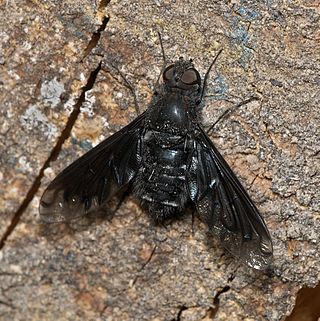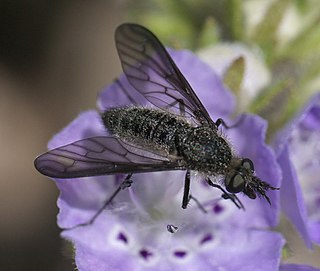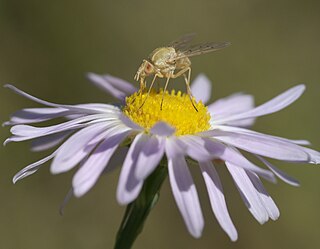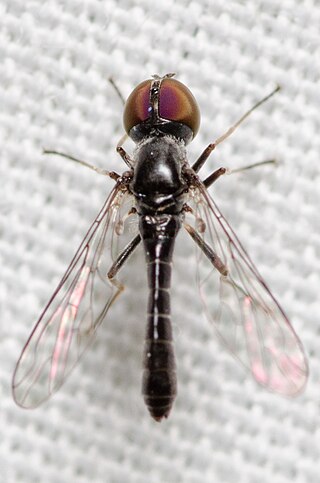
The Bombyliidae are a family of flies, commonly known as bee flies. Some are colloquially known as bomber flies. Adults generally feed on nectar and pollen, some being important pollinators. Larvae are mostly parasitoids of other insects.

Anthrax is a genus of bombyliid flies, commonly known as "bee-flies" due to their resemblance to bees. Most are dull black flies, and are usually small to medium in size, 4–20 millimetres (0.2–0.8 in), and many species have striking wing patterns.

Heterostylum is a genus of flies belonging to the family Bombyliidae (bee-flies). There are 14 described species, distributed throughout the Americas. These are robust and very hairy flies with a body length of 10–15 mm. They can be distinguished from similar genera by an indentation in the hind margin of the eye and unique wing venation.

Villa is a genus of flies belonging to the bee-fly family (Bombyliidae). They range in size from 5 to 17 millimetres, and have typically rounded heads. The males of some species have a brilliant mat of silvery patagial scales. About 270 Villa species are found on all continents except Antarctica. They can be distinguished from similar genera (Hemipenthes) by their wing venation.

Hemipenthes is a large genus of flies belonging to the family Bombyliidae (bee-flies). There are many described species, distributed throughout the Holarctic realm. These are small to large robust flies with a body length of 5–14 mm. They can be distinguished from similar genera (Villa) by their wing venation. A number of species formerly in this genus were moved to a separate genus, ins in 2020.

Anthracinae is a subfamily of bee flies in the family Bombyliidae. There are more than 80 genera and 2,000 described species in Anthracinae.

Bombyliinae is a subfamily of bee flies in the family Bombyliidae. There are more than 70 genera in Bombyliinae.
Aphoebantus is a genus of bee flies. There are at least 80 described species in Aphoebantus.

Lordotus is a genus of bee flies. There are at least 30 described species in Lordotus.

Poecilognathus is a genus of bee flies. There are at least 20 described species in Poecilognathus.

Villini is a tribe of bee flies in the family Bombyliidae.

Thevenetimyia is a genus of bee flies in the family Bombyliidae. There are more than 40 described species in Thevenetimyia found worldwide, mostly in North America with several species in Australia and southeast Asia.

Chrysanthrax is a genus of bee flies in the family Bombyliidae.

Lepidanthrax is a genus of bee flies in the family Bombyliidae. There are at least 50 described species in Lepidanthrax.

Tomomyzinae is a subfamily of bee flies in the family Bombyliidae. There are at least 6 genera and more than 50 described species in Tomomyzinae.

Aphoebantini is a tribe of bee flies in the family Bombyliidae. There are about 5 genera and at least 80 described species in Aphoebantini.

Cythereinae is a subfamily of bee flies in the family Bombyliidae. There are about 19 genera and 150 species in Cythereinae.

Neacreotrichus is a genus of bee flies in the family Bombyliidae. There are about 13 described species in Neacreotrichus, found in the United States and Mexico.


















